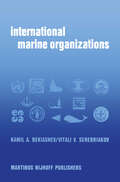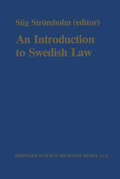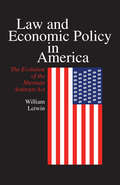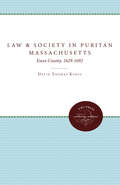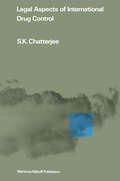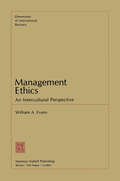- Table View
- List View
A Great Trial in Chinese History: The Trial of the Lin Biao and Jiang Qing Counter-Revolutionary Cliques, Nov. 1980 - Jan. 1981
by Unknown AuthorA Great Trial in Chinese History: The Trial of the Lin Biao and Jiang Qing Counter-Revolutionary Cliques, Nov. 1980 - Jan. 1981 focuses on the influence of the trial of the two cliques of Lin Biao and Jiang Qing on Chinese law, particularly the separation of criminal and political liabilities. The book first underscores the setting up of a Special Procuratorate and special court, defense lawyers, and start of trial and highlights of court investigation. Discussions focus on the framing and persecution of state chairman Liu Shaoqi, false charges against Premier Zhou Enlai, frame-ups by Jiang Qing, rebellion plot in Shanghai, and counter-revolutionary propaganda. The text then examines court debate, including the denial of Huang Yongsheng as the chief culprit, the request of Chen Boda for leniency, the silence of Zhang Chunqiao, and the guilty plea of Wang Hongwen. The publication takes a look at the judgment of the court, comments, and documents. Topics include articles of China's criminal law relevant to the judgment of the Lin-Jiang case; milestone in socialist democracy and socialist legality; and indictment of the Special Procuratorate under the Supreme People's Procuratorate of the People's Republic of China.The manuscript is a vital source of data for historians and readers interested in the Lin Biao and Jiang Qing trial.
H. L. A. Hart; 1st Edition (Jurists: Profiles In Legal Theory)
by William Twining D. Neil MacCormick1st Edition
Handbuch der kommunalen Wissenschaft und Praxis: Band 1: Grundlagen und Kommunalverfassung (Monographien Aus Dem Gesamtgebiet Der Physiologie Der Pflanzen Und Der Tiere Ser. #1)
by Günter PüttnerDas Handbuch der kommunalen Wissenschaft und Praxis (HKWP) ist das führende Standardwerk im Bereich der Kommunalwissenschaften. Mit seinem Konzept, den aktuellen Forschungsstand mehrerer geisteswissenschaftlicher Fächer mit dem empirischen Wissen der Praxis zu kombinieren, ist es seit nunmehr über fünfzig Jahren ohne Konkurrenz. Auch in seiner dritten Auflage dokumentiert es die aktuellen Forschungsergebnisse der Kommunalwissenschaften als Schnittstelle mehrerer geisteswissenschaftlicher Disziplinen und vereint somit Untersuchungen aus den Bereichen Rechtswissenschaft, Wirtschaftswissenschaften, Politikwissenschaft, Soziologie und Historik in einem Werk. Ergänzt wird dieser disziplinüberschreitende Ansatz durch die Einbindung des empirischen Wissens kommunaler Praktiker. Das HKWP besteht in dritter Auflage aus den Teilbänden "Grundlagen und Kommunalverfassung", "Kommunale Wirtschaft", "Kommunale (Fach-)Aufgaben " sowie "Kommunale Finanzen".
The Hunters or the Hunted?: An Introduction to African Cave Taphonomy
by C. K. Brain"Amongst scientists involved [in taphonomy], C. K. Brain stands out as the pioneer; this impressive book is a statement of his investigations. . . . The Hunters or the Hunted? is a very important book for paleoanthropology. It presents the first thorough analysis of the Sterkfontein Valley assemblages, contributes significantly to the resolution of lingering controversies and, by placing the old information in a fresh perspective, enables new and more sophisticated questions to be asked not only of the South African material but of similar assemblages elsewhere. Another contribution is that it reinforces the recent change in feelings as to what constitutes data, for the value of looking at fossil and contemporary bones as closely as this is clear. Brain urges the necessity of recovering fossils with a high regard for subtle detail. I hope excavators of any vertebrate fossil site will be persuaded to follow his advice and pay more attention to these features of bone accumulations that have been previously neglected; for taphonomy can be a powerful tool in elucidating the problems of fossil assemblages, especially when handled with the care and caution that Brain brings to the subject."—Andrew Hill, Nature
Individuelle und kollektive Koalitionsfreiheit: Rechtliche Ausgestaltung, Betätigungsbereiche, Umfeld
by G. SchwerdtfegerInternational Marine Organizations: Essays on Structure and Activities
by K.A. Bekiashev V.V. SerebriakovIn the last few years, the quantity of books and papers on the political, economic and legal problems of the exploration and use of the sea and marine resources has considerably increased. But the status and activities of intern a tional organizations related to maritime shipping, fisheries, scientific research in the World Ocean and the protection of the marine environment have not yet, as a whole, been represented in the scientific and reference literature. It would be fair, though, to mention that some general information on marine international organizations may be found in the Yearbook of International Organizations, Brussels, 1979; in Annotated Acronyms and Abbreviations of Marine Science Related International Organizations, U. S. Department of Commerce, 1976; and in the UN Annotated Directory ofIntergovernmental Organizations Concerned with Ocean Affairs, 1976. Voluminous informa tion on organizations engaged in problems of the exploration and use ofthe sea is given in International Marine Organizations by the well-known Polish scientists Lopuski and Symonides, 1978. Meanwhile the increasing volume of practical work related to the participa tion of governmental and scientific bodies as well as individual scientists and specialists in these organizations, the necessity of long-term planning in this field, and the perspectives of the development of these organizations, make necessary a special publication depicting the structure and many-sided activi ties of such international bodies. This book is the first one in which the most complete information on the main marine international organizations is presented.
An Introduction to Swedish Law: Volume 1
by Stig StrömholmTO SWEDISH LAW VOLUME I AN INTRODUCTION TO SWEDISH LAW VOLUME I EDITED BY STIG STROMHOLM SPRINGER SCIENCE+BUSINESS MEDIA, LLC ISBN 978-94-017-4349-5 ISBN 978-94-017-4347-1 (eBook) DOI 10. 1007/978-94-017-4347-1 ©Springer Science+Business Media New York 1981 Originally published by Kluwer Deventer, The Netherlands in 1981 Softcoverreprint ofthe hardcover 1st edition 1981 All rights reserved. No part ofthis publication may be reproduced, stored in a retrieval system, or Iransmitted in any form by any means, electronic, mechanical, photocopy ing, recording or otherwise, without the prior written permission ofthe publisher. EDITOR'S PREFACE The purpose of this book is to provide a fairly broad survey of the Swedish legal system. In order to avoid possible disappointment, it would seem important to make clear from the outset what kind of questions the authors propose to answer and what groups of readers they are addressing. The easiest way to do this is to set out what we are not purporting to do. Thus, the book is not intended to serve as a primer for students who possess no knowledge of "the law", i. e. of the concepts, ideas and solutions of at least one legal system. Nor is it the purpose of the authors to give practitioners the kind of precise, techni cal answers to isolated questions that they need when advising their clients on the proper course of action in business, or litigation, con ducted within the framework of the legal system described.
Is Science Sexist?: And Other Problems in the Biomedical Sciences (The Western Ontario Series in Philosophy of Science #17)
by M. RusePhilosophy of biology has a long and honourable history. Indeed, like most of the great intellectual achievements of the Western World, it goes back to the Greeks. However, until recently in this century, it was sadly neglected. With a few noteworthy exceptions, someone wishing to delve into the subject had to choose between extremes of insipid vitalism on the one hand, and sterile formalizations of the most elementary biological principles on the other. Whilst philosophy of physics pushed confidently ahead, the philosophy of biology languished. In the past decade, however, things have changed dramatically. A number of energetic and thoughtful young philosophers have made real efforts to master the outlines and details of contemporary biology. They have shown that many stimulating problems emerge when analytic skills are turned towards the life-sciences, particularly if one does not feeI con strained to stay only with theoretical parts of biology, but can range over to more medical parts of the spectrum. At the same time, biology itself has had one of the most fruitful yet turbulent periods in its whole history, and more and more biologists have grown to see that many of the problems they face take them beyond the narrow confines of empiric al science: a broader perspective is needed.
A Joint Venture Agreement for Seabed Mining (Studies in Transnational Law of Natural Resources #5)
by G. JaenickeThe Third Uni ted Nations Conference on the Lawof the Sea is preparing rules far the establishment of an international legal regime governing the exploration and exploitation of the resources of the international seabed. The Draft Convention on the Law of the Sea (Informal Text) of 27 August 1980 which has so far been the result of the negotiations during the preceding sessions of the Conference, provides for a so-called "parallel system" under which an international "Enterprise" as weIl as national private or state-owned companies will be granted access to the resources of the international seabed under the control of an International Seabed Authority. The Draft Convention also envisages the condusion of joint venture agreements between the international Enterprise and national companies or consortia, and encourages such cooperation through grant ing various incentives. Such joint ventures will probably play an important part in making the international Enterprise operative in the early years of its existence. At the Conference concerns have been expressed whether and when the Enterprise as a newcomer would be in a position to start seabed mining and to compete effectively with the national companies. The Draft Convention provides for a number of ways and means to enable the Enterprise to develop its technological and financial capabilities for deep sea mining as early as possible.
Justice and Health Care (Philosophy and Medicine #8)
by Earl E. ShelpBioethics is a discipline still not fully explored in spite of its rather remark able expansion and sophistication during the past two decades. The prolifer ation of courses in bioethics at educational institutions of every description gives testimony to an intense academic interest in its concerns. The media have catapulted the dilemmas of bioethics out of the laboratory and library into public view arid discussion with a steady report of the so-called 'mira cles of modern medicine' and the moral perplexities which frequently accom pany them. The published work of philosophers, theologians, lawyers and others represents a substantial and growing body of literature which explores relevant concepts and issues. Commitments have been made by existing in stitutions, and new institutions have been chartered to further the discussion of the strategic moral concerns that attend recent scientific and medical progress. This volume focuses attention on one of the numerous topics of interest within bioethics. Specifically, an examination is made of the implications of the principle of justice for health care. Apart from four essays in Ethics and Health Policy edited by Robert Veatch and Roy Branson [4] the dis cussion of justice and health care has been occasional, almost non-existent, and scattered. The paucity of literature in this area is regrettable but perhaps understandable. On the one hand, Joseph Fletcher, one of the contemporary pioneers in bioethics, can hold that "distributive justice is the core or key question for biomedical ethics" ([1], p. 102).
The Justice Motive in Social Behavior: Adapting to Times of Scarcity and Change (Critical Issues in Social Justice)
by Melvin J. Lerner Sally C. LernerThis volume was conceived out of the concern with what the imminent future holds for the "have" countries ... those societies, such as the United States, which are based on complex technology and a high level of energy consumption. Even the most sanguine projection includes as base minimum relatively rapid and radical change in all aspects of the society, reflecting adaptation or reactions to demands created by poten tial threat to the technological base, sources of energy, to the life-support system itself. Whatever the source of these threats-whether they are the result of politically endogeneous or exogeneous forces-they will elicit changes in our social institutions; changes resulting not only from attempts to adapt but also from unintended consequences of failures to adapt. One reasonable assumption is that whatever the future holds for us, we would prefer to live in a world of minimal suffering with the greatest opportunity for fulfilling the human potential. The question then becomes one of how we can provide for these goals in that scenario for the imminent future ... a world of threat, change, need to adapt, diminishing access to that which has been familiar, comfortable, needed.
Juveniles’ Waiver of Rights: Legal and Psychological Competence (Perspectives in Law & Psychology #3)
by Thomas GrissoThe research studies reported in this book were completed between June, 1976 and November, 1979, with a USPHS research grant (MH- 27849) from the Center for Studies of Crime and Delinquency, National Institute of Mental Health. Every phase of the project was an exercise in combining the research methods of psychology with the concerns of law, legal systems, and legal process. Research psychologists will be especially interested in our efforts to apply psychological constructs and research methods to a difficult decision-making problem in law. This report describes in some detail the project's development of experimental measures of psychological condi tions related to legal standards and demonstrates the ways in which research design was influenced by concerns of law and the juvenile justice system. Lawyers, judges, and youth advocate groups have already ex pressed considerable interest in the implications of the project's results for the formation and modification of juvenile law and procedure. In each chapter, I have attempted to describe carefully the ways in which the empirical research results are applicable to these concerns, and I have tried to specify the limits which must be acknowledged in inter preting the results for application in the legal process.
Kriminalität in der DDR: Zur Phänomenologie des abweichenden Verhaltens im sozialistischen deutschen Staat (Studien zur Sozialwissenschaft #45)
by Arnold FreiburgLaw and Economic Policy in America: The Evolution of the Sherman Antitrust Act
by William LetwinWilliam Letwin's thorough, carefully argued, and elegantly written work is the only book length study of the Sherman Antitrust Act, a law designed to shape the economic life of a large complex society through maintaining the "correct" level of competition in the economy. This is a superb history and complete analysis of the Act, from its English and American common law antecedents to the events that led to the first revisions of the Act in the form of the Clayton Antitrust and Federal Trade Commission Acts.
Law and Society in Puritan Massachusetts: Essex County, 1629-1692 (Studies in Legal History)
by David Thomas KonigDistinguished by the critical value it assigns to law in Puritan society, this study describes precisely how the Massachusetts legal system differed from England's and how equity and an adapted common law became so useful to ordinary individuals. The author discovers that law gradually replaced religion and communalism as the source of social stability, and he gives a new interpretation to the witchcraft prosecutions of 1692.Originally published 1979.A UNC Press Enduring Edition -- UNC Press Enduring Editions use the latest in digital technology to make available again books from our distinguished backlist that were previously out of print. These editions are published unaltered from the original, and are presented in affordable paperback formats, bringing readers both historical and cultural value.
The Law-Medicine Relation: Proceedings of the Eighth Trans-Disciplinary Symposium on Philosophy and Medicine Held at Farmington, Connecticut, November 9–11, 1978 (Philosophy and Medicine #9)
by Stuart F. Spicker, Joseph M. Healey and H. Tristram EngelhardtThis volume is a contribution to the continuing interaction between law and medicine. Problems arising from this interaction have been addressed, in part, by previous volumes in this series. In fact, one such problem constitutes the central focus of Volume 5, Mental Illness: Law and Public Policy [1]. The present volume joins other volumes in this series in offering an exploration and critical analysis of concepts and values underlying health care. In this volume, however, we look as well at some of the general questions occasioned by the law's relation with medicine. We do so out of a conviction that medi cine and the law must be understood as the human creations they are, reflect ing important, wide-ranging, but often unaddressed aspects of the nature of the human condition. It is only by such philosophical analysis of the nature of the conceptual foundations of the health care professions and of the legal profession that we will be able to judge whether these professions do indeed serve our best interests. Such philosophical explorations are required for the public policy decisions that will be pressed upon us through the increasing complexity of health care and of the law's response to new and changing circumstances. As a consequence, this volume attends as much to issues in public policy as in the law. The law is, after all, the creature of human deci sions concerning prudent public policy and basic human rights and goods.
Lectures on the Relation Between Law and Public Opinion in England During the Nineteenth Century (Social Science Classics)
by Albert Venn DiceyThe famed 1914 edition of this classic is one of the small handful of works that deserve to be read by Americans to understand the 1980s. Indeed, the final three chapters, describing the decline of will and consensus in late Victorian England, stand as a stark, unmistakable reminder that such national decline can happen again. Dicey was the most influential constitutional authority in late Victorian and Edwardian Britain. Modern politicians have often invoked the phrase "rule of law." So commonplace has it become that few recognize its source in the work of Dicey. Law and Public Opinion in England is written with simplicity, wit and a sense of purpose that marks it as a book apart. It did much more than fortell the decline of empire, it developed the forms in which such decline comes about. In many ways this book represents a pioneering statement on the libertarian tradition as a consequence of rather than rebellion against the legal norms of an advanced civilization. This is a central book for students of society and politics alike.
Lectures on the Relation Between Law and Public Opinion in England During the Nineteenth Century (Social Science Classics)
by Albert Venn DiceyThe famed 1914 edition of this classic is one of the small handful of works that deserve to be read by Americans to understand the 1980s. Indeed, the final three chapters, describing the decline of will and consensus in late Victorian England, stand as a stark, unmistakable reminder that such national decline can happen again. Dicey was the most influential constitutional authority in late Victorian and Edwardian Britain. Modern politicians have often invoked the phrase "rule of law." So commonplace has it become that few recognize its source in the work of Dicey. Law and Public Opinion in England is written with simplicity, wit and a sense of purpose that marks it as a book apart. It did much more than fortell the decline of empire, it developed the forms in which such decline comes about. In many ways this book represents a pioneering statement on the libertarian tradition as a consequence of rather than rebellion against the legal norms of an advanced civilization. This is a central book for students of society and politics alike.
Legal Aspects of International Drug Control
by S.K. ChatterjeeThe need for suppressing the illicit traffic in drugs can hardly be over-emphasized. Yet, the licit uses of drugs, especially for medical and scientific needs, cannot be suppressed. Apparently, it is a ques tion of determining the vvorld requirements of drugs for such legiti mate uses, and of producing and manufacturing them accordingly. Owing to their multifarious medical uses in various parts of the world, it proves to be almost impossible to determine exactly the amount of drugs required for legitimate purposes. There is also the complicating factor that drugs are used for sociological and religious reasons, which have a long history. Not only arc the licit uses and legitimate amounts of drugs difficult to determine but also such difficulties give rise to illicit traffic in them. Yet, it is believed that a concerted international policy, coupled with national co-operation, on various facets of the related problems-namely, limitation of production and/or manufacture of drugs, restriction on cultivation of plants that may contribute to addiction-producing substances, training and rehabilitation of drug addicts, and efficient national administration-would help eradicate drug-abuse. In search of an appropriate remedy, this book has been devoted to a practical study of the problem and to exploring, in this area of international law, the relationship between the political and econ omic interests and the international economic order.
Legal Aspects of Joint Ventures in Eastern Europe
by Dennis CampbellDENNIS CAMPBELL AND MARK MILLER Introduction Within the last decade, there has been significant expansion in both the frequency and quantity of direct foreign investment by Western countries and multinational 1 corporations (MNC's) in the forni of joint ventures in Eastern Europe. These joint ventures, as well as other forms of mutual-cooperation trade arrangements, represent positive evidence of the increasing enthusiasm towards East-West trans actions now found on both sides of the European frontier. The spirit with which Western governments and business interests have sought to expand involvement in the East European market has been well documented. However, there has been relatively little attention paid to the extremely important internal changes which have come about within the foreign-trade policies of the Eastern European coun tries and which have served to accommodate the growth of trade with the West. This dramatic increase in direct foreign investment in the form of joint ventures results primarily from the passage of enabling legislation in a number of the East European states, legislation which has facilitated and attracted business invest ment from the West. Thus, it is opportune to examine and review the policy reforms and amendments which have been enacted in Eastern Europe and the Western responses thereto. As a preliminary matter, the term 'joint venture', as well as other mechanisms for foreign investment as used here, should be defined and distinguished.
Management Ethics: An Intercultural Perspective (Dimensions of International Business #1)
by W.A. EvansSociety is a nexus of individual perceptions. The world is as we each see it, no more and no less. To hope that we shall all agree on what is good or bad is to hope in vain. This is not solipsism transferred to moral philosophy; it is realism born of observation. This book tries to remind its readers that you can be responsible only if you understand the basis of your responsibility; that you can exercise responsibility only if you have the power to do so; that you cannot lay down a conceptual framework of behavior in business if you have no framework of life; that every facet of your conduct as a manager and employee involves a delicate balance between rebellion and absolute conformity. Indeed, it may be that the hardest lesson is that of learning that compliance and silence and obedience are frequently more desirable than protest when all stands to be lost. To gamble on a poor card hand is the act of either an excessively foolish or a supremely clever man; since the proper judgment of risk is an uncommon facility, poor hands are normally lost. There is no such thing as a corporate attitude, just as there is no such thing as the will of the people.
Mental Health Law: Major Issues (Perspectives in Law & Psychology #4)
by David B. WexlerTHE CORE OF MENTAL HEALTH LAW A musty file in Arizona's Greenlee County Courthouse reveals that on January 22, 1912, shortly before Arizona became a state, a 19-year-old Mexican-American woman residing in Morenci was taken into custody and placed in the county jail by a deputy sheriff who, that same day, filed with the Greenlee County Probate Court the following commit ment petition: Have known girl about one year. Last summer-July or Aug. 19- commenced to act irrational. Has been under treatment of physicians past 4 months. They called me this A.M. and told me they were unable to treat her successfully-that she is crazy and I must arrest her. The proposed patient was apparently examined the next day by two physicians, who duly completed the required medical questionnaire. In addition to mentioning that the patient's physical health was good, that she was "cleanly" in her personal habits, that she did not use liquor, tobacco, or drugs, and that neither she nor any of her relatives had ever been mentally ill or hospitalized in the past, the doctors listed the follow ing information on those portions of the form devoted to mental illness and dangerousness: Dangerousness: No threats or attempts to commit suicide or murder. Is of a very happy temperament. Has a tendency to laugh and sing. Facts indicating insanity: She wanted to dance. Most of conversation was fairly rational.







